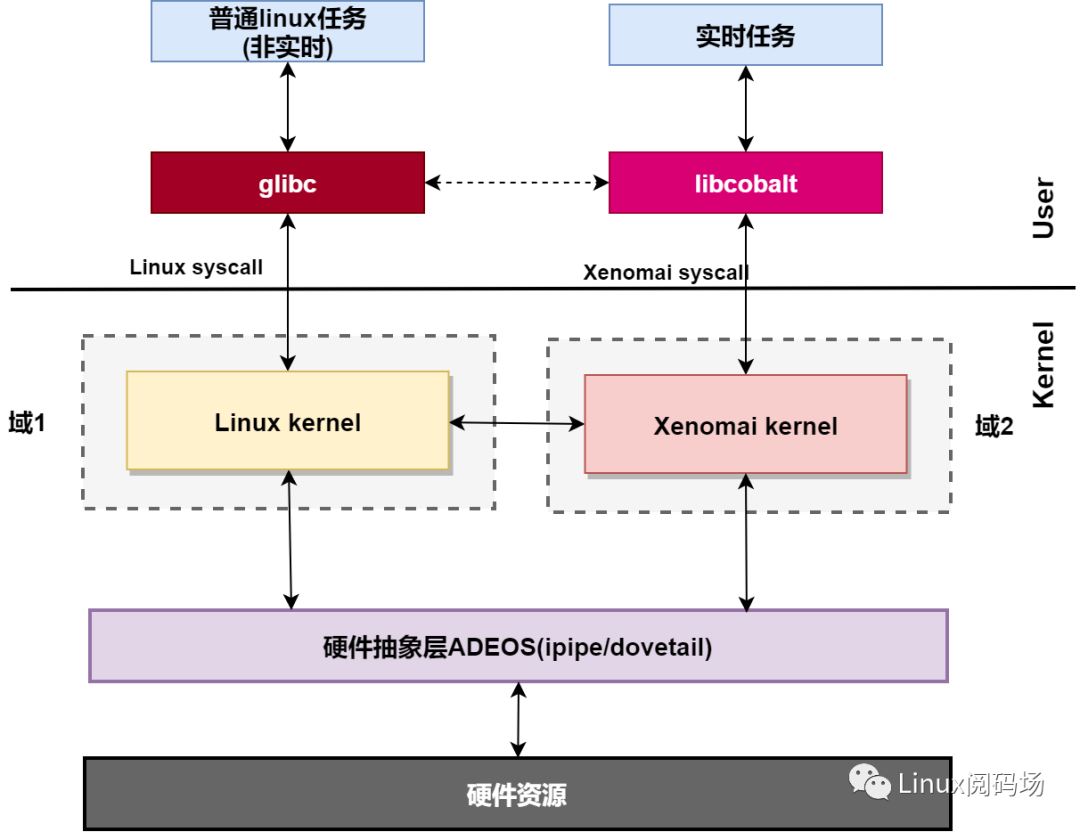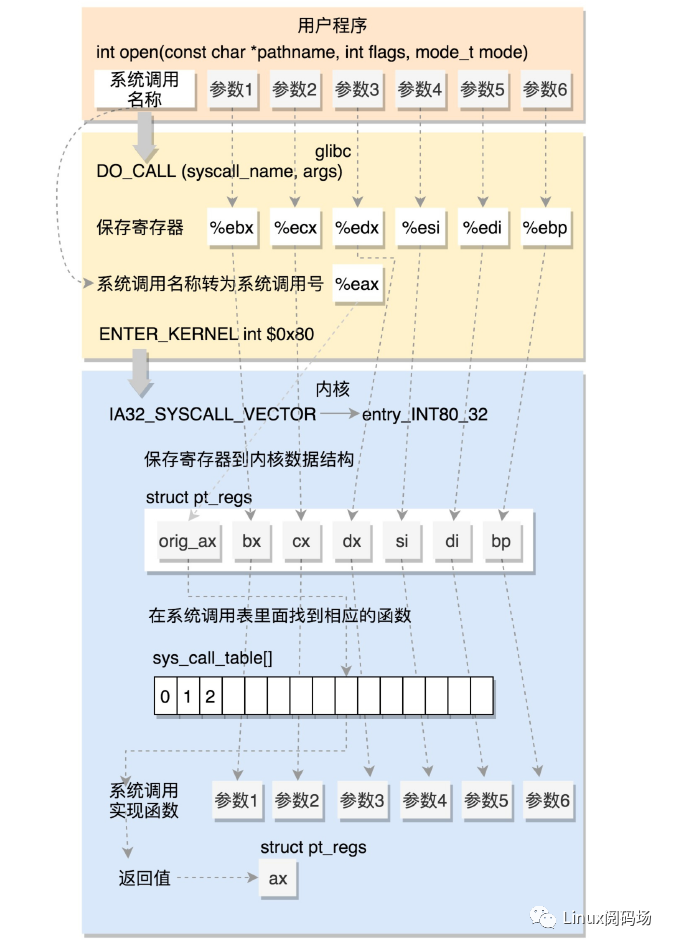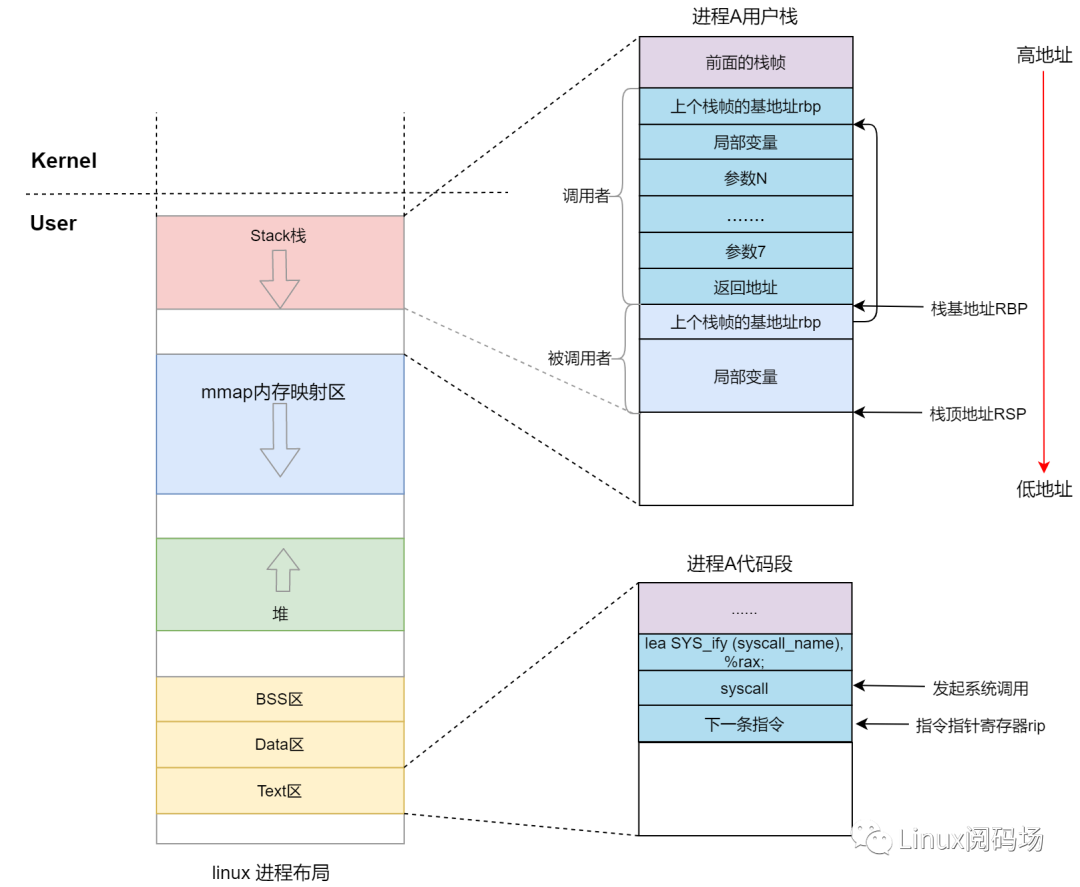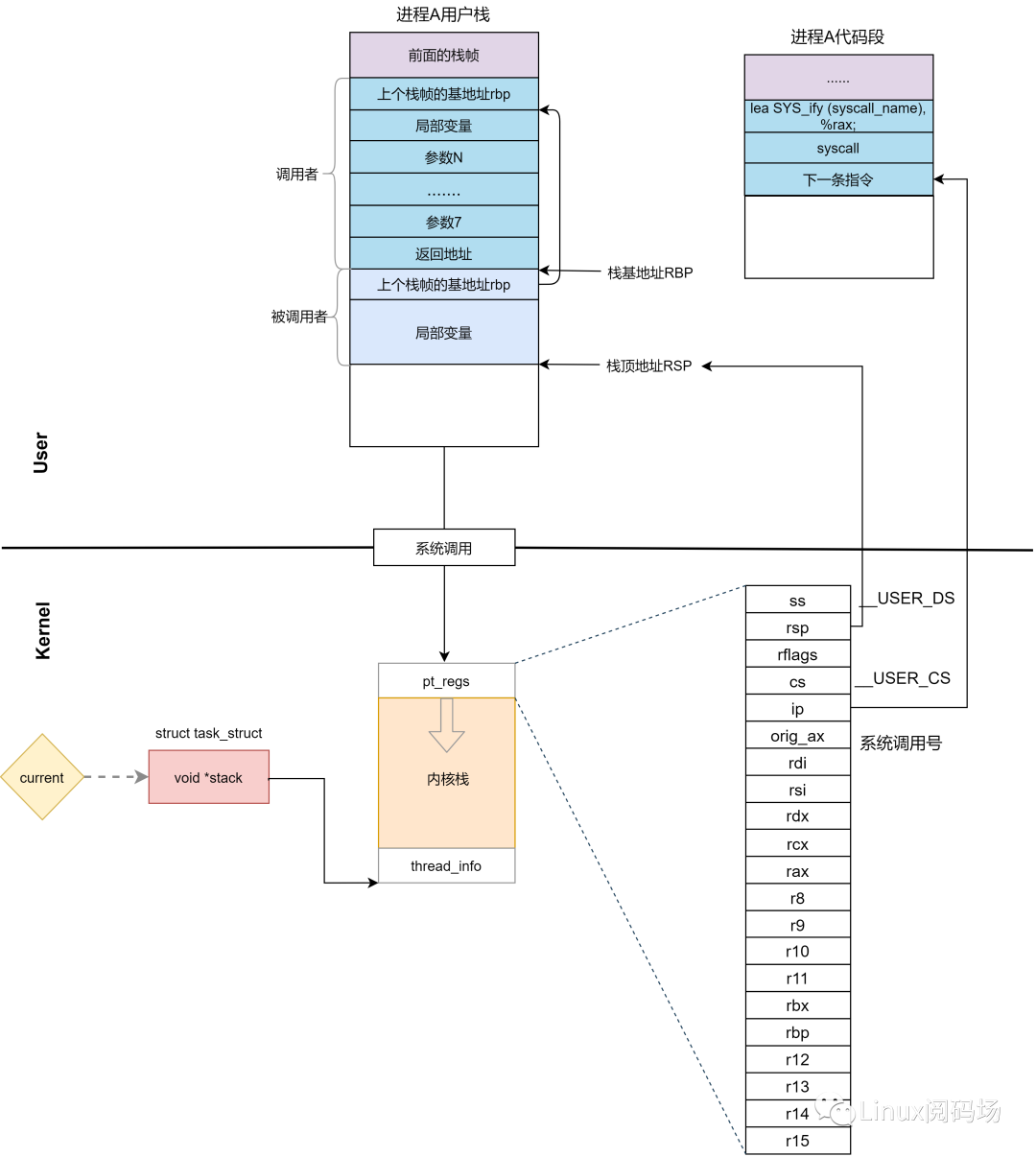

双核系统调用(ipipe)
描述
双核系统调用(ipipe)
解析系统调用是了解内核架构最有力的一把钥匙。
在Linux内核基础上加入xenomai实时系统内核后,在内核空间两个内核共存,实时任务需要xenomai内核来完成实时的服务,如果实时任务需要用到linux的服务,还可以调用linux内核的系统调用,你可能会好奇xenomai与linux两个内核共存后系统调用是如何实现的?

为什么需要系统调用?现代操作系统中,处理器的运行模式一般分为两个空间:内核空间和用户空间,大部分应用程序运行在用户空间,而操作系统内核和设备驱动程序运行在内核空间,如果应用程序需要访问硬件资源或者需要内核提供服务,该怎么办?
为了向用户空间上运行的应用程序提供服务,内核提供了一组接口。透过该接口,应用程序可以访问硬件设备和其他操作系统资源。这组接口在应用程序和内核之间扮演了使者的角色,应用程序发送各种请求,而内核负责满足这些请求,这些接口就是系统调用,它是用户空间和内核空间一个中间层。
系统调用层主要作用有三个:
-
它为用户空间提供了一种统一的硬件的抽象接口。比如当需要读些文件的时候,应用程序就可以不去管磁盘类型和介质,甚至不用去管文件所在的文件系统到底是哪种类型。
-
系统调用保证了系统的稳定和安全。应用程序要访问内核就必须通过系统调用层,内核可以在系统调用层对应用程序的访问权限、用户类型和其他一些规则进行过滤,这避免了应用不正确地访问内核,保证了系统和各个应用程序的安全性。
-
可移植性。可以让应用程序在不修改源代码的情况下,在不同的操作系统或拥有不同硬件架构的系统中重新编译运行。
回到本文开头的问题,该问题细分为如下两个问题:
-
双核共存时,如何区分应用发起的系统调用是xenomai内核调用还是linux内核调用?
-
一个xenomai实时任务既可以调用xenomai内核服务,也可以调用linux内核服务,这是如何做到的?
本文通过分析源代码为你解答问题1,对于问题2,涉及双核间的调度,本文暂不涉及,后面的文章揭晓答案。
一、32位Linux系统调用
我们先来看没有ipipe和xenomai内核时的linux系统调用流程是怎样的。linux操作系统的API通常以C标准库的方式提供,比如linux中的libc库。C标准库中提供了POSIX的绝大部分API实现,glibc为了提高应用程序的性能,还对一些系统调用进行了封装。此外,由于32位系统系统调用使用软中断 int0x80指令实现,应用程序也可以通过汇编直接进行系统调用。软中断属于异常的一种,通过执行该指令陷入(trap)内核,trap在整理的文档 x86Linux中断系统有说明。内核初始化过程中,通过函数 tarp_init()设置IDT(Interrupt Descriptor Table 记录每个中断异常处理程序的地址的一张表),有关 int0x80的IDT表项如下:
static const __initconst struct idt_data def_idts[] = {......SYSG(IA32_SYSCALL_VECTOR, entry_INT80_32),......};
当产生系统调用时,硬件根据向量号在 IDT 中找到对应的表项,即中断描述符,进行特权级检查,发现 DPL = CPL = 3 ,允许调用。然后硬件将切换到内核栈 (tss.ss0 : tss.esp0)。接着根据中断描述符的 segment selector 在 GDT / LDT 中找到对应的段描述符,从段描述符拿到段的基址,加载到 cs 。将 offset 加载到 eip。最后硬件将 ss / sp / eflags / cs / ip / error code 依次压到内核栈。于是开始执行 entry_INT80_32函数,该函数在 entry_32.S定义:
ENTRY(entry_INT80_32)ASM_CLACpushl %eax /* pt_regs->orig_ax */SAVE_ALL pt_regs_ax=$-ENOSYS /* *存储当前用户态寄存器,保存在pt_regs结构里*//** User mode is traced as though IRQs are on, and the interrupt gate* turned them off.*/TRACE_IRQS_OFFmovl %esp, %eaxcall do_int80_syscall_32.Lsyscall_32_done:........Lirq_return:INTERRUPT_RETURN/*iret 指令将原来用户态保存的现场恢复回来,包含代码段、指令指针寄存器等。这时候用户态进程恢复执行。*/
在内核栈的最高地址端,存放的是结构 ptregs,首先通过 push 和 SAVEALL 将当前用户态的寄存器,保存在栈中 ptregs 结构里面.保存完毕后,关闭中断,将当前栈指针保存到 eax,即doint80syscall32的参数1。调用doint80syscall32=>dosyscall32irqs_on。先看看没有ipipe时Linux实现如下:
__always_inline void do_syscall_32_irqs_on(struct pt_regs *regs){struct thread_info *ti = pt_regs_to_thread_info(regs);unsigned int nr = (unsigned int)regs->orig_ax;.....if (likely(nr < IA32_NR_syscalls)) {nr = array_index_nospec(nr, IA32_NR_syscalls);regs->ax = ia32_sys_call_table[nr]( /*根据系统调用号索引直接执行*/(unsigned int)regs->bx, (unsigned int)regs->cx,(unsigned int)regs->dx, (unsigned int)regs->si,(unsigned int)regs->di, (unsigned int)regs->bp);}syscall_return_slowpath(regs);}
在这里,将系统调用号从pt_reges中eax 里面取出来,然后根据系统调用号,在系统调用表中找到相应的函数进行调用,并将寄存器中保存的参数取出来,作为函数参数。如果仔细比对,就能发现,这些参数所对应的寄存器,和 Linux 的注释是一样的。ia32_sys_call_table系统调用表生成后面解析(此图来源于网络)。

相关内核调用执行完后,一直返回到 dosyscall32irqson ,如果系统调用有返回值,会被保存到 regs->ax 中。接着返回 entryINT8032 继续执行,最后执行 INTERRUPTRETURN 。INTERRUPTRETURN 在 arch/x86/include/asm/irqflags.h 中定义为 iret ,iret 指令将原来用户态保存的现场恢复回来,包含代码段、指令指针寄存器等。这时候用户态进程恢复执行。
系统调用执行完毕。
二、32位实时系统调用
xenomai+linux双内核架构下,通过I-pipe 拦截系统调用,并将系统调用定向到实现它们的系统。
实时系统调用,除了直接通过汇编系统调用外,xenomai还实现了libcoblat实时库,相当于glibc,通过libcoblat进行xenomai系统调用,以libcoblat库函数sem_open为例,libcolat库中C函数实现如下:
COBALT_IMPL(sem_t *, sem_open, (const char *name, int oflags, ...)){......err = XENOMAI_SYSCALL5(sc_cobalt_sem_open,&rsem, name, oflags, mode, value);if (err == 0) {if (rsem != sem)free(sem);return &rsem->native_sem;}.......return SEM_FAILED;}
libcolat库调用系统调用使用宏 XENOMAI_SYSCALL5,XENOAI_SYSCALL宏在 includeasmxenomaisyscall.h中声明, XENOMAI_SYSCALL5中的'5'代表'该系统调用有五个参数:
({unsigned __resultvar;asm volatile (LOADARGS_##nrDOSYSCALLRESTOREARGS_##nr: (__resultvar): (__xn_syscode(op)) ASMFMT_##nr(args): , );(int) __resultvar;})
每个宏中,内嵌另一个宏DOSYSCALL,即实现系统调用的int指令:int$0x80。
define DOSYSCALL "int $0x80
"
系统调用过程硬件处理及中断入口上节一致,从 do_syscall_32_irqs_on开始不同,有ipipe后变成下面这样子:
static __always_inline void do_syscall_32_irqs_on(struct pt_regs *regs){struct thread_info *ti = current_thread_info();unsigned int nr = (unsigned int)regs->orig_ax;/*取出系统调用号*/int ret;ret = pipeline_syscall(ti, nr, regs);/*pipeline 拦截系统调用*/......done:syscall_return_slowpath(regs);}
套路和ipipe接管中断类似,在关键路径上拦截系统调用,然后调用 ipipe_handle_syscall(ti,nr,regs)让ipipe来接管处理:
int ipipe_handle_syscall(struct thread_info *ti,unsigned long nr, struct pt_regs *regs){unsigned long local_flags = READ_ONCE(ti->ipipe_flags);int ret;if (nr >= NR_syscalls && (local_flags & _TIP_HEAD)) {/*运行在head域且者系统调用号超过linux*/ipipe_fastcall_hook(regs); /*快速系统调用路径*/local_flags = READ_ONCE(ti->ipipe_flags);if (local_flags & _TIP_HEAD) {if (local_flags & _TIP_MAYDAY)__ipipe_call_mayday(regs);return 1; /* don't pass down, no tail work. */} else {sync_root_irqs();return -1; /* don't pass down, do tail work. */}}if ((local_flags & _TIP_NOTIFY) || nr >= NR_syscalls) {ret =__ipipe_notify_syscall(regs);local_flags = READ_ONCE(ti->ipipe_flags);if (local_flags & _TIP_HEAD)return 1; /* don't pass down, no tail work. */if (ret)return -1; /* don't pass down, do tail work. */}return 0; /* pass syscall down to the host. */}
这个函数的处理逻辑是这样,怎样区分xenomai系统调用和linux系统调用?每个CPU架构不同linux系统调用总数不同,在x86系统中有300多个,用变量 NR_syscalls表示,系统调用号与系统调用一一对应。首先获取到的系统调用号 nr>=NR_syscalls,不用多想,那这个系统调用是xenomai内核的系统调用。另外还有个问题,如果是Linux非实时任务触发的xenomai系统调用,或者xenomai 实时任务要调用linux的服务,这些交叉服务涉及实时任务与非实时任务在两个内核之间运行,优先级怎么处理等问题。这些涉及 cobalt_sysmodes[].
首先看怎么区分一个任务是realtime还是norealtime。在 task_struct结构的头有一个成员结构体 thread_info,存储着当前线程的信息,ipipe在结构体 thread_info中增加了两个成员变量 ipipe_flags和 ipipe_data, ipipe_flags用来来标示一个线程是实时还是非实时,TIPHEAD置位表示已经是实时上下文。对于需要切换到xenomai上下文的系统调用TIP_NOTIFY置位。
struct thread_info {unsigned long flags; /* low level flags */u32 status; /* thread synchronous flags */unsigned long ipipe_flags;struct ipipe_threadinfo ipipe_data;};
ipipe_handle_syscall处理逻辑:1.对于已经在实时上下文的实时任务发起xenomai的系统调用,使用快速调用路径函数 ipipe_fastcall_hook(regs);2.需要切换到实时上下文或者非实时调用实时的,使用慢速调用路径:
_ipipenotifysyscall(regs)->ipipesyscallhook(callerdomain, regs)
快速调用 ipipe_fastcall_hook(regs)内直接 handle_head_syscall执行代码如下:
static int handle_head_syscall(struct ipipe_domain *ipd, struct pt_regs *regs){....code = __xn_syscall(regs);nr = code & (__NR_COBALT_SYSCALLS - 1);......handler = cobalt_syscalls[code];sysflags = cobalt_sysmodes[nr];........ret = handler(__xn_reg_arglist(regs));.......ret);.......}
这个函数很复杂,涉及xenomai与linux之间很多联系,代码是简化后的,先取出系统调用号,然后从 cobalt_syscalls取出系统调用入口handler,然后执行 handler(__xn_reg_arglist(regs))执行完成后将执行结果放到寄存器 ax,后面的文章会详细分析ipipe如何处理系统调用。
三、 64位系统调用
我们再来看 64 位的情况,系统调用,不是用中断了,而是改用 syscall 指令。并且传递参数的寄存器也变了。
({unsigned long __resultvar;LOAD_ARGS_LOAD_REGS_asm volatile ("syscall ": "=a" (__resultvar): "0" (name) ASM_ARGS_: "memory", "cc", "r11", "cx");(int) __resultvar;})DO_SYSCALL(__xn_syscode(op), nr, args)XENOMAI_DO_SYSCALL(1, sc_cobalt_bind, breq)
这里将系统调用号使用 __xn_syscode(op)处理了一下,把最高位置1,表示Cobalt系统调用,然后使用syscall 指令。
syscall 指令还使用了一种特殊的寄存器,我们叫特殊模块寄存器(Model Specific Registers,简称 MSR)。这种寄存器是 CPU 为了完成某些特殊控制功能为目的的寄存器,其中就有系统调用。在系统初始化的时候,trapinit 除了初始化上面的中断模式,这里面还会调用 cpuinit->syscall_init。这里面有这样的代码:
wrmsrl(MSR_LSTAR, (unsigned long)entry_SYSCALL_64);
rdmsr 和 wrmsr 是用来读写特殊模块寄存器的。MSRLSTAR 就是这样一个特殊的寄存器, 当 syscall 指令调用的时候,会从这个寄存器里面拿出函数地址来调用,也就是调entrySYSCALL64。该函数在'entry64.S'定义:
ENTRY(entry_SYSCALL_64)UNWIND_HINT_EMPTY......swapgs/** This path is only taken when PAGE_TABLE_ISOLATION is disabled so it* is not required to switch CR3.*/movq %rsp, PER_CPU_VAR(rsp_scratch)movq PER_CPU_VAR(cpu_current_top_of_stack), %rsp/* Construct struct pt_regs on stack */pushq $__USER_DS /* pt_regs->ss */pushq PER_CPU_VAR(rsp_scratch) /* pt_regs->sp */pushq %r11 /* pt_regs->flags */pushq $__USER_CS /* pt_regs->cs */pushq %rcx /* pt_regs->ip *//*保存用户太指令指针寄存器*/GLOBAL(entry_SYSCALL_64_after_hwframe)pushq %rax /* pt_regs->orig_ax */PUSH_AND_CLEAR_REGS rax=$-ENOSYSTRACE_IRQS_OFF/* IRQs are off. */movq %rsp, %rdicall do_syscall_64 /* returns with IRQs disabled */TRACE_IRQS_IRETQ /* we're about to change IF *//** Try to use SYSRET instead of IRET if we're returning to* a completely clean 64-bit userspace context. If we're not,* go to the slow exit path.*/movq RCX(%rsp), %rcxmovq RIP(%rsp), %r11cmpq %rcx, %r11 /* SYSRET requires RCX == RIP */jne swapgs_restore_regs_and_return_to_usermode.......testq $(X86_EFLAGS_RF|X86_EFLAGS_TF), %r11jnz swapgs_restore_regs_and_return_to_usermode/* nothing to check for RSP */cmpq $__USER_DS, SS(%rsp) /* SS must match SYSRET */jne swapgs_restore_regs_and_return_to_usermode/** We win! This label is here just for ease of understanding* perf profiles. Nothing jumps here.*/syscall_return_via_sysret:/* rcx and r11 are already restored (see code above) */UNWIND_HINT_EMPTYPOP_REGS pop_rdi=0 skip_r11rcx=1/** Now all regs are restored except RSP and RDI.* Save old stack pointer and switch to trampoline stack.*/movq %rsp, %rdimovq PER_CPU_VAR(cpu_tss_rw + TSS_sp0), %rsppushq RSP-RDI(%rdi) /* RSP */pushq (%rdi) /* RDI *//** We are on the trampoline stack. All regs except RDI are live.* We can do future final exit work right here.*/SWITCH_TO_USER_CR3_STACK scratch_reg=%rdipopq %rdipopq %rspUSERGS_SYSRET64END(entry_SYSCALL_64)
这里先保存了很多寄存器到 pt_regs 结构里面,例如用户态的代码段、数据段、保存参数的寄存器.

然后调用 entry_SYSCALL64_slow_pat->do_syscall_64。
__visible void do_syscall_64(struct pt_regs *regs){struct thread_info *ti = current_thread_info();unsigned long nr = regs->orig_ax; /*取出系统调用号*/int ret;enter_from_user_mode();enable_local_irqs();ret = ipipe_handle_syscall(ti, nr & __SYSCALL_MASK, regs);if (ret > 0) {disable_local_irqs();return;}if (ret < 0)goto done;......if (likely((nr & __SYSCALL_MASK) < NR_syscalls)) {nr = array_index_nospec(nr & __SYSCALL_MASK, NR_syscalls);regs->ax = sys_call_table[nr](regs->di, regs->si, regs->dx,regs->r10, regs->r8, regs->r9);}done:syscall_return_slowpath(regs);}
与32位一样,ipipe拦截了系统调用,后面的处理流程类似所以,无论是 32 位,还是 64 位,都会到linux系统调用表 sys_call_table和xenomai系统调用表 cobalt_syscalls[]这里来。
四、 实时系统调用表cobalt_syscalls
xenomai每个系统的系统系统调用号在 cobaltuapisyscall.h中:
......
bind()函数在内核代码中对应的声明和实现为:
/*声明*/long CoBaLt_static COBALT_SYSCALL_DECL(bind, lostage,(struct cobalt_bindreq __user *u_breq));/*实现*/#define COBALT_SYSCALL(__name, __mode, __args)long CoBaLt_ ## __name __argsstatic COBALT_SYSCALL(bind, lostage,(struct cobalt_bindreq __user *u_breq)){......}
其中 __name表示系统调用名对应bind、 __mode表示该系统调用模式对应lostage。 COBALT_SYSCALL展开定义的bind函数后如下:
long CoBaLt_bind(struct cobalt_bindreq __user *u_breq){......}
怎么将 CoBaLt_bind与系统调用号 sc_cobalt_bind联系起来后放入 cobalt_syscalls[]的呢?在编译过程中Makefile使用脚本 gen-syscall-entries.sh处理各个 .c文件中的COBALTSYSCALL宏,生成一个头文件 syscall_entries.h,里面是对每个COBALTSYSCALL宏处理后后的项,以上面 COBALT_SYSCALL(bind,...)为例 syscall_entries.h中会生成如下两项,第一项为系统调用入口,第二项为系统调用的模式:
实时系统调用表 cobalt_syscalls[]定义在文件 kernelcobaltposixsyscall.c中:
[] = __COBALT_NI,__COBALT_CALL32_INITHAND(__COBALT_NI)[] = 0,__COBALT_CALL32_INITMODE(0)[] = __syshand__(__name),__COBALT_CALL32_ENTRY(__name, __syshand__(__name))[] = __xn_exec_static const cobalt_syshand cobalt_syscalls[] = {__COBALT_CALL_NI__COBALT_CALL_ENTRIES};static const int cobalt_sysmodes[] = {__COBALT_CALL_NFLAGS__COBALT_CALL_MODES};
_COBALTCALLNI宏表示数组空间大小为__NRCOBALTSYSCALLS(128),每一项由COBALTCALL_ENTRIES定义,即脚本头文件 syscall_entries.h中生成的每一项来填充:
#define __COBALT_CALL_ENTRY(__name)[sc_cobalt_ ## __name] = __syshand__(__name),__COBALT_CALL32_ENTRY(__name, __syshand__(__name))
__COBALT_CALL32_ENTRY是定义兼容的系统调用,宏展开如下,相当于在数组的多个位置定义包含了同一项CoBaLt_bind:
#define __COBALT_CALL32_ENTRY(__name, __handler)__COBALT_CALL32x_ENTRY(__name, __handler)__COBALT_CALL32emu_ENTRY(__name, __handler)#define __COBALT_CALL32emu_ENTRY(__name, __handler)[sc_cobalt_ ## __name + 256] = __handler,#define __COBALT_CALL32x_ENTRY(__name, __handler)[sc_cobalt_ ## __name + 128] = __handler,
最后bind系统调用在cobalt_syscalls[]中如下
static const cobalt_syshand cobalt_syscalls[] = {[sc_cobalt_bind] = CoBaLt_bind,[sc_cobalt_bind + 128] = CoBaLt_bind, /*x32 support */[sc_cobalt_bind + 256] = CoBaLt_bind, /*ia32 emulation support*/.....};
相应的数组cobalt_sysmodes[]中的内容如下:
static const int cobalt_sysmodes[] = {[sc_cobalt_bind] = __xn_exec_bind,[sc_cobalt_bind + 256] = __xn_exec_lostage, /*x32 support */[sc_cobalt_bind + 128] = __xn_exec_lostage, /*ia32 emulation support*/......};
五、实时系统调用权限控制cobalt_sysmodes
上面说到,ipipe管理应用的系统调用时需要分清该系统调用是否合法,是否需要域切换等等。cobalt_sysmodes[]就是每个系统调用对应的模式,控制着每个系统调用的调用路径。系统调用号为下标,值为具体模式。每个系统调用的sysmode如何生成见上一节,还是以实时应用的bind系统调用为例:
static const int cobalt_sysmodes[] = {[] = __xn_exec_bind,[] = __xn_exec_lostage, /*x32 support */[] = __xn_exec_lostage, /*ia32 emulation support*/......};
xenomai中所有的系统调用模式定义如下:
/*xenomaiposixsyscall.c*/#define __xn_exec_lostage 0x1 /*必须在linux域运行该系统调用*/#define __xn_exec_histage 0x2 /*必须在Xenomai域运行该系统调用*/#define __xn_exec_shadow 0x4 /*影子系统调用:必须映射调用方*/#define __xn_exec_switchback 0x8 /*切换回切换;调用者必须返回其原始模式*/#define __xn_exec_current 0x10 /*在不管域直接执行。*/#define __xn_exec_conforming 0x20 /*在兼容域(Xenomai或Linux)中执行*/#define __xn_exec_adaptive 0x40 /* 先直接执行如果返回-ENOSYS,则尝试在相反的域中重新执行系统调用 */#define __xn_exec_norestart 0x80 /*收到信号后不要重新启动syscall*//*Shorthand初始化系统调用的简写*/#define __xn_exec_init __xn_exec_lostage/*Xenomai空间中shadow系统调用的简写*/#define __xn_exec_primary (__xn_exec_shadow|__xn_exec_histage)/*Linux空间中shadow系统调用的简写*/#define __xn_exec_secondary (__xn_exec_shadow|__xn_exec_lostage)/*Linux空间中syscall的简写,如果有shadow则切换回linux*/#define __xn_exec_downup (__xn_exec_lostage|__xn_exec_switchback)/* 主域系统不可重启调用的简写 */#define __xn_exec_nonrestartable (__xn_exec_primary|__xn_exec_norestart)/*域探测系统调用简写*/#define __xn_exec_probing (__xn_exec_conforming|__xn_exec_adaptive)/*将模式选择移交给syscall。*/#define __xn_exec_handover (__xn_exec_current|__xn_exec_adaptive)
使用一个无符号32 位数的每一位来表示一种模式,各模式注释已经很清楚,不在解释,后面文章解析ipipe是如何根据mode来处理的。
参考
英特尔 64 位和 IA-32 架构软件开发人员手册第 3 卷 :系统编程指南极客时间专栏-趣谈Linux操作系统《linux内核源代码情景分析》
审核编辑 :李倩
-
请问canmv-k230支持双核吗?如何调用另一个核心工作?2025-04-23 459
-
4核系统应用2019-06-21 2175
-
基于双核MCU提高系统性能2019-07-04 4424
-
如何采用非对称双核MCU提高系统性能?2021-04-02 2814
-
怎么实现ARM/DSP双核系统的通信接口的设计?2021-05-26 1287
-
基于AXI总线的MicroBlaze双核SoPC系统设计2012-03-09 1715
-
双核处理器的视频监控系统设计2017-10-26 1175
-
AXI总线的MicroBlaze双核SoPC系统设计2017-10-31 1297
-
vivado调用IP核详细介绍2018-05-28 38556
-
FPGA应用之vivado三种常用IP核的调用2023-02-02 4991
全部0条评论

快来发表一下你的评论吧 !

